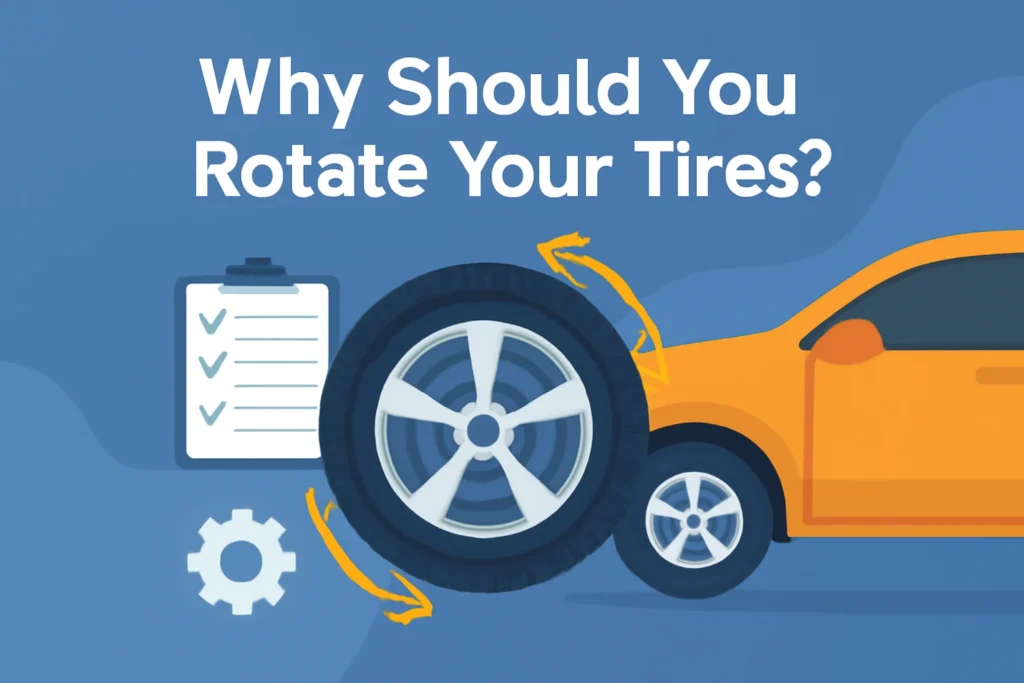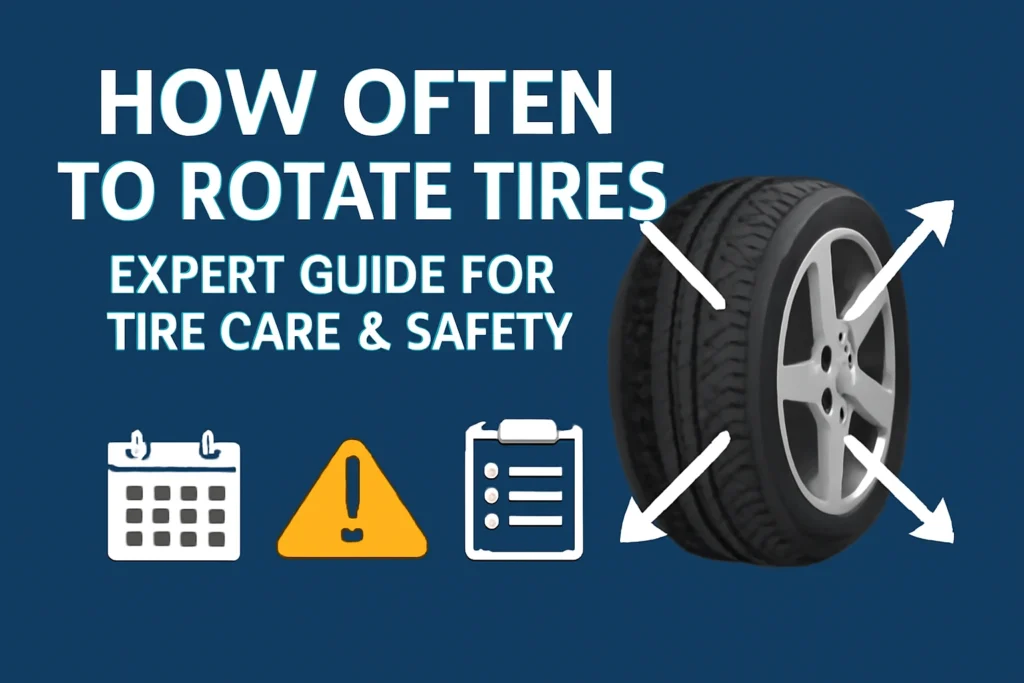Introduction
Tire rotation is really important if you want your vehicle to run smoothly and your tires to last longer. Knowing how often to rotate tires usually around every 5,000 miles makes a big difference. By switching the rear tires to the front regularly, you help your tires wear evenly, which keeps your car safer and handles better. If tires wear unevenly, it can cause problems like shaky steering and even hurt your gas mileage. This routine is especially important for Hondas and cars with AWD or FWD systems. Sticking to the right rotation schedule means you get the most out of your tires and stay safe on the road.
What is Tire Rotation?
Tire rotation involves moving tires from one position to another to ensure even tire wear. This simple maintenance step helps extend the life of your tires by balancing the wear between front and rear tires. Different vehicles, such as front-wheel drive (FWD), rear-wheel drive (RWD), and all-wheel drive (AWD), require specific rotation patterns to optimize performance. For example, performing a FWD tire rotation is crucial, while AWD cars need more frequent rotation to avoid drivetrain issues. Proper tire rotation not only improves safety and handling but also maximizes tire life, making it an essential part of tire care and maintenance for all vehicle types.
Rotation Basics for Different Vehicles
FWD, RWD, and AWD vehicles each have unique rotation patterns due to how power is distributed, and understanding these can help you know when to rotate. AWD vehicles especially need regular tire rotation to prevent uneven tire wear that could damage the drivetrain.
Why Should You Rotate Your Tires?
Rotating your tires regularly helps extend their life by promoting even tire wear, which in turn improves fuel efficiency and enhances overall safety on the road; knowing when to rotate is essential. Unevenly worn tires can lead to poor handling and increased risk of accidents. Additionally, many vehicle warranties require consistent tire rotation to remain valid, making it a crucial part of maintaining your car’s optimal performance. Keeping up with tire rotation also helps avoid costly repairs down the line and ensures you get the most out of your tires, especially if they need to be rotated every 5000 miles.

Tire Care and Maintenance Tips
For best results, combine tire rotation with regular wheel alignment checks and maintaining proper tire pressure, especially when you have new tires and need to get your tires rotated. Remember, if tires show severe wear or damage, it’s time to replace them rather than rotate, as AWD tires need special attention.
How Often Should You Rotate Your Tires?
Most experts recommend rotating your tires every 5,000 miles, though this can vary based on your vehicle type and driving habits, especially for FWD tire rotation. For example, Honda owners should follow their owner’s manual, which usually suggests rotation around every 5000 miles to maintain optimal performance. AWD vehicles need more frequent rotations—typically every 5,000 to 6,000 miles—to prevent uneven tire wear and protect the drivetrain. FWD and RWD vehicles generally rotate tires every 5,000 to 7,000 miles, with front tires on FWD cars wearing faster due to steering and power delivery, so keep that in mind for your tire rotation needs. Road conditions, tire type, and driving style also affect how often you should rotate your tires.
Recommended Tire Rotation Intervals
| Vehicle Type | Recommended Mileage for Rotation | Notes |
|---|---|---|
| Front-Wheel Drive (FWD) | Every 5,000 – 7,000 miles | Front tires wear faster due to steering and power delivery |
| Rear-Wheel Drive (RWD) | Every 5,000 – 7,000 miles | Rear tires wear differently; cross rotation recommended |
| All-Wheel Drive (AWD) | Every 5,000 – 6,000 miles | Rotation critical to avoid drivetrain damage |
| Honda Vehicles | Check owner’s manual; typically every 5,000 miles | Some models have specific rotation patterns |
Tire Rotation Patterns for Different Vehicles
Tire rotation patterns vary depending on the type of vehicle you drive. Common patterns include front-to-back, cross pattern, and rearward diagonal rotations, which can also involve keeping the rear tires on the same side. Front-wheel drive (FWD) vehicles typically use a front-to-back pattern, while rear-wheel drive (RWD) often benefits from a cross pattern to balance wear. All-wheel drive (AWD) vehicles require more specific rotation schedules to maintain even tire wear and protect the drivetrain. Following the correct rotation pattern helps prevent uneven tire wear, which can lead to poor handling and reduced tire life.
Performing a Proper Tire Rotation
To rotate tires properly, start by moving the front tires to the rear on the same side, and the rear tires to the front but crossed to the opposite side (for most vehicles). Incorrect rotation, such as swapping front tires to the back without following the recommended pattern, can cause uneven wear and reduce tire longevity, especially in RWD cars. Always consult your vehicle’s manual for the best rotation method.
Signs Your Tires Need to Be Rotated
Uneven tire wear is a clear sign that your tires need rotation. You might notice one tire wearing down faster than others or unusual tread patterns. Handling issues, such as pulling to one side or vibrations while driving, also indicate uneven wear. Regularly inspecting your tires helps catch these problems early, ensuring safety and prolonging tire life. Tire care isn’t just about mileage—it’s about staying attentive to how your tires perform and look.
When to Schedule a Tire Rotation
Schedule a tire rotation every 5,000 to 7,000 miles, or sooner if you notice uneven wear or handling problems, to keep the rear tires in good condition and ensure they need to be rotated every interval. Don’t wait until tires are visibly worn; timely rotation helps maintain traction and prevents costly repairs down the road. If your vehicle’s manufacturer provides a specific maintenance schedule, following it closely is best to ensure that you know when to rotate every recommended interval.
Related Resources for Vehicle Maintenance and Insurance
Exploring Technology Job Trends in 2025
Stay informed about the evolving job market by exploring the latest trends in technology employment. Discover how many jobs are available and what the future holds in this detailed article on how many miles to rotate tires. how many jobs are available in technology in 2025.
Comprehensive Guide to Full Coverage Insurance for Financed Cars
Protecting your financed vehicle is essential. Learn everything you need to know about full coverage insurance and how it safeguards your investment by reading our guide on full coverage insurance for financed cars.
Visit Techy Infinity for More Informative Articles
For a wide range of useful tips and articles related to vehicles, insurance, and more, including how often tires should be rotated every 5000 miles, explore our main site at Techy Infinity.
Frequently Asked Questions (FAQs)
How often should I rotate my tires on a Honda?
Most Honda models recommend tire rotation every 5000 miles, but it’s best to check your owner’s manual for specific guidance based on your model, especially if you need new tires.
Can I rotate tires myself, or should I get professional service?
While you can rotate tires yourself with the right tools and knowledge, professional service ensures the correct rotation pattern, such as moving the rear tires to the front, and includes safety checks.
What happens if I don’t rotate my tires regularly?
Skipping regular tire rotations can cause uneven tire wear, reducing tire lifespan and negatively affecting vehicle safety and fuel efficiency, especially if you need to rotate your tires sooner than expected.
Does AWD require more frequent tire rotation?
Yes, AWD vehicles typically need more frequent rotations—around every 5,000 to 6,000 miles—to keep the drivetrain balanced and tires wearing evenly.
Can tire rotation fix wheel alignment issues?
No, wheel alignment is a separate maintenance service but should be checked during tire rotation appointments to ensure optimal tire performance, especially since my last tire rotation.
Conclusion
Regular tire rotation is essential for maximizing tire life and maintaining vehicle safety. By following the manufacturer’s recommended maintenance schedule, you can prevent uneven wear, improve handling, and enhance fuel efficiency, ensuring that your tires are rotated every 5,000 to 7,000 miles. Combining tire rotation with proper wheel alignment and consistent tire care ensures your tires perform at their best, helping you get the most value and safety from every mile you drive, particularly with AWD tires.


